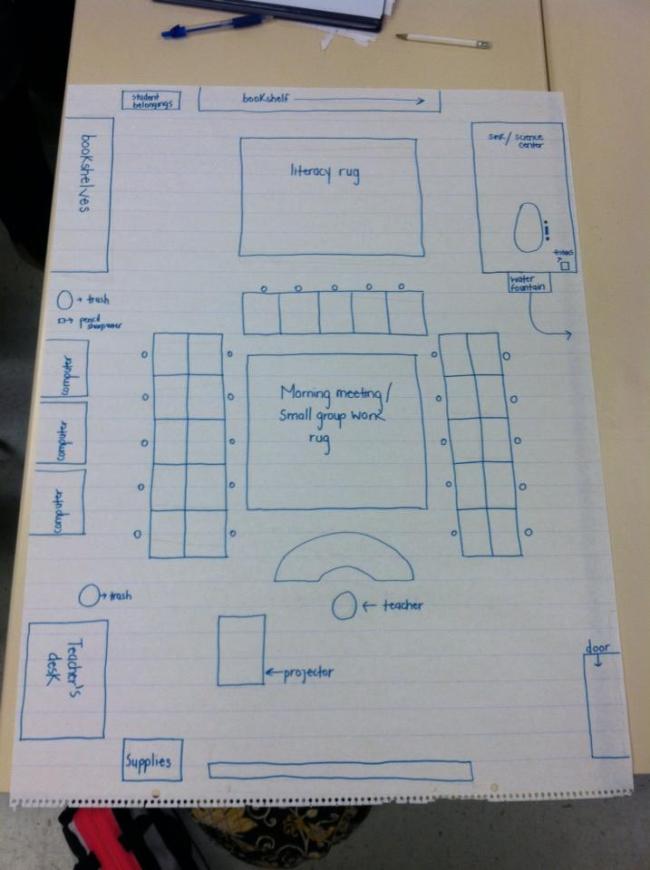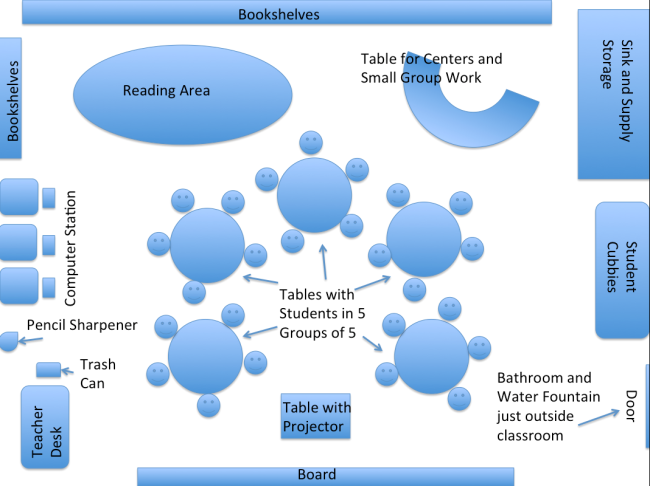This week was the final week of our course in classroom management. I learned about many different theories and philosophies regarding how to manage behavior in the classroom as well as particular strategies that can be used in establishing a sense of community.
In an earlier post I had developed a classroom layout design for a class of 25 students, as seen below.
Later, for another assignment, I created this alternate classroom layout design for the same hypothetical 25 students I had written about in my previous post.
Here is the accompanying description for the above layout, which I believe reflects a greater emphasis on community and the value of small group work than my previous layout. “The twenty-five students in the class are seated at five tables in groups of five. There are five students in the class who are high achievers and social leaders with an ability to influence others. One of them will be placed at each of the tables in the hopes that their influence will positively affect the behavior of their classmates. Seating arrangements in which high-achieving and low-achieving students are sitting together throughout the room facilitates student involvement and participation (Levin & Nolan, 2010). The seating of students in groups is in keeping with the classroom emphasis on community and group work. Students such as those with learning disabilities will benefit from small group work as well as the ELL students in the class who will be placed at different tables in the classroom.”
In another part of the paper containing this classroom layout design, I also wrote about a few routines and strategies I would employ in my classroom that seemed to be extremely beneficial to community building and behavior management. Some of those strategies and routines included Morning Meeting (Kriete, 2002), redirection (Rothstein-Fisch & Trumbull, 2008), and the Peace Table (Bullard, 2008).
More than anything, I think the biggest thing I learned from this course is that no matter what management style you personally have, there is a large amount of prior planning involved. Even teachers whose classrooms are more student-directed must begin with particular routines and strategies in mind to guide students to this point. Structure and routine aren’t just for the reward/coercive, assertive discipline teachers of the world. Building a community takes some serious time and planning.
References
Bullard, S. (2008). Peace takes practice. In Teaching Tolerance (Ed.), Starting small: Teaching tolerance in preschool and the early grades (pp. 63-75). Montgomery, AL: Southern Poverty Law Center.
Kriete, R. (2002). The Morning Meeting Book (2nd ed.). Turners Falls, MA: Northeast Foundation for Children.
Levin, J., & Nolan, J. F. (2010). Principles of classroom management: A professional decision-making model (6th ed.). Boston, MA: Pearson.
Rothstein-Fisch, C., & Trumball, E. (2008). Managing diverse classrooms: How to build on students’ cultural strengths. Alexandria, Virginia: ASCD.


Hi Monica!
I like that you posted both of your classroom layouts side-by-side. This is one of the areas of classroom management that is tricky for me, so I am interested in how everyone has planned out their rooms. I love the second layout–I wouldn’t have thought to use round tables, but they really free up space!
I also love that you added a peace table. That is one of my favorite ideas from the whole semester, because it provides a medium for students to practice social skills while solving problems at the same time.
Thanks for the post, I enjoyed reading it 🙂
-Britt